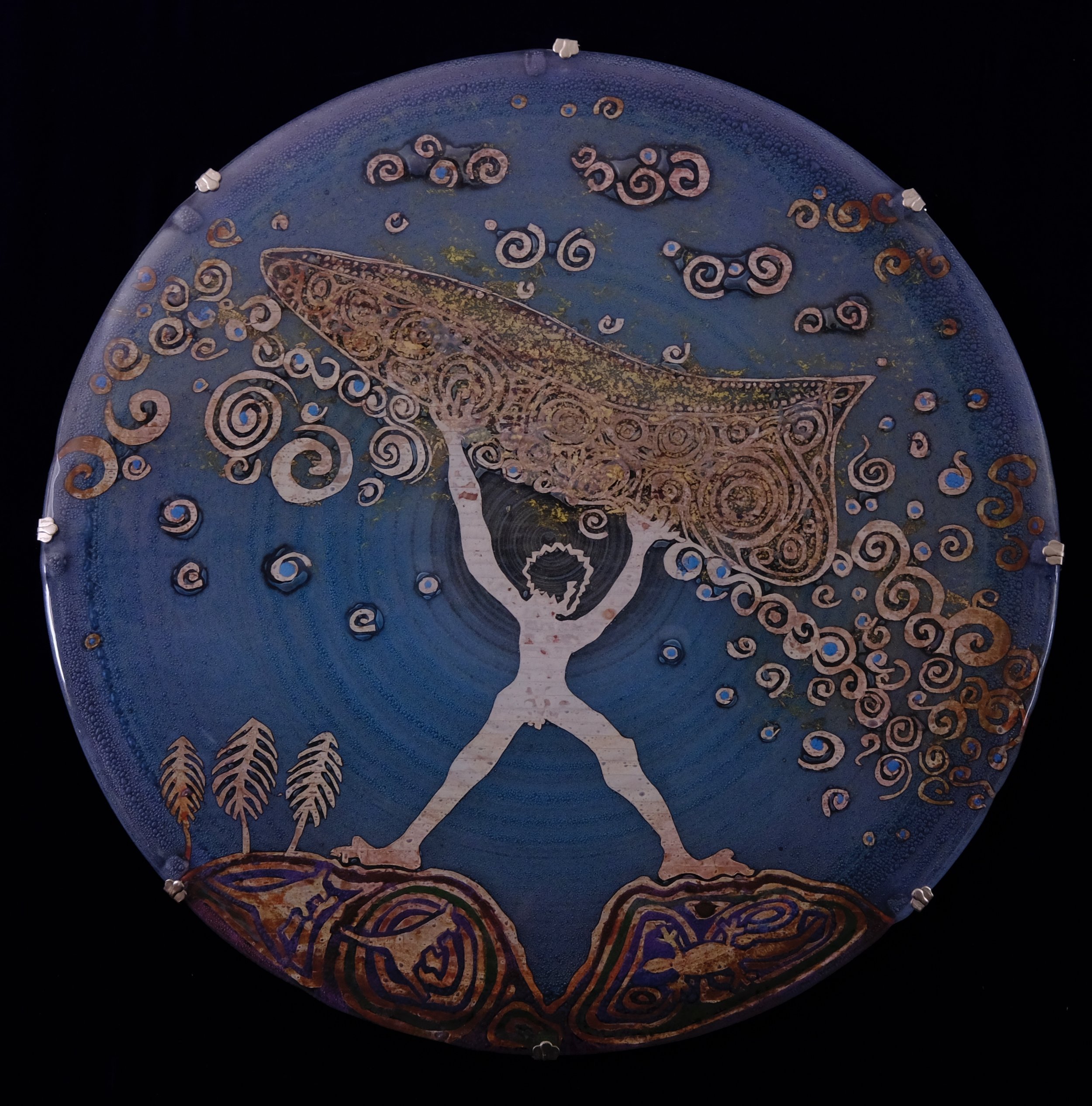Feature artwork Orion Nebula Reimagined by Sabrina Dowling Giudici.
Earth | Sea | Sky
Glass Art Exhibition
12-23 April 2023, Parish Hall Gallery, 12 Francis Street, Carnarvon, Western Australia
Featuring Sabrina Dowling Giudici with Laksar Burra and Greg Ash. Artworks, artists proofs and digital catalogue available - Text +61400411999 direct.
This exhibition is curated by Sabrina Dowling Giudici in her role as an artist and science communicator. Sabrina presents interpretations of sky stories with respected and award-winning Australian senior glass artists, Laksar Burra and Greg Ash.
Together, the three glass artists explore the connection between the sky world and our earth home, using colour, form, and the materiality of kiln-formed glass.
In trying to understand our place in the universe, old wisdom knowledge and new frontiers of space science, are presented contemporaneously in this evolving collection of glass objects for storytelling. Laksar Burra is a master storyteller and leads this exhibition with his approach of how Aboriginal peoples and Western Science look at the same night sky and read different meanings into the night sky patterns.
Laksar Burra
Laksar Burra trained at St Martins in London and at the University of Adelaide. A riveting storyteller, he both speaks and writes stories as entrusted to him for sharing, by the people with whom he lived in Central Australia and elsewhere.
Following are excerpts from his book, “Spirit of the Night Sky”. Celebrating Creation in the Night Skies p.8 Wherever we go in the world we find people and cultures whose stories celebrate the night skies. The Aboriginal people of South Australia tell the tale of Nurrun deri… Nurrunderi, the Creator, went fishing one day. As it happens, he caught the biggest fish in the universe. “Such a magnificent fish requires a special home,” the Creator said. So Nurrunderi created the Murray River. And Nurrunderi made many other fish and set them in the Murray so the great Codfish would have friends to play with. Nurrunderi was tired after all his efforts and needed to rest. His brother-ion-law had a quiet place so Nurrunderi decided to stay with to recuperate.
After a while Nurrunderi felt himself again. But he was lonely. His wives, who usually took care of him, were not there. He missed them very much indeed and decided to find out where his wives had gone while he’s been recuperating. Until now Nurrunderihad used his magic canoe to travel around the waterways of creation. But Nurrunderi knew his search for his wives would take him far overland and he wouldn’t be able to take his canoe with him.
He looked for a safe place to leave it.
That night, as Nurrunderi was considering his options, he looked up at the night sky and saw a great dark empty space where the canoe would fit perfectly.
Nearby there were two big sand dunes. Nurrunderi stood with one foot on each dune. Then he dragged his canoe and began to lift it up, higher and higher. The sweat from his exertion ran in rivulets which formed puddles on the ground. Finally, Nurrunderi succeeded in hoisting his canoe to the safe place in the sky. There, he could keep an eye on it as he travelled in search of his wives.
In South Australia they call it Nurrunderi Juki, the Canoe of Nurrunderi.
We call it the Milky Way…
Canoe of Nurrunderi, Laksar Burra, kiln-formed glass with copper inclusions, framed, 500mm diameter, Cordially on loan from private collection.
Aurora Australia, 2023, Greg Ash, kiln-formed glass, 300mm x 180mm diameter. Contact for purchase.
Greg Ash
Greg Ash is a senior Australian glass artist, award winner for nearly three decades, including Tascraft. He has trained with an extraordinary range of world masters including Klaus Moje, Kirstie Rea, Narcissus Quagliata, Bob Leatherbarrow Dan Clayman, Gerry King and Rudi Gritsch.
His technical grasp of glass work is evident in the range of vessels he creates using the drop-form method.
During 2023, Earth has experienced an bewildering array of auroras in both hemispheres. The captivating colours have been interpreted by Greg in this vase, featured in this exhibition.
Additional exhibition series include Earth, Blue Skies, Sunsets, and Sunrises.
Eclipse 2023, 2023, Sabrina Dowling Giudici, kiln-formed glass, 120mm x 160mm diameter. Contact for purchase.
Sabrina Dowling Giudici
Sabrina has been mesmerised by the night sky since a child. Her younger years were spent in Carnarvon, Western Australia, location of the largest NASA Tracking Station outside of the U.S.A. responsible for the all the Apollo moon landings. In 1994, Sabrina ran in Carnarvon, the first astrotours in WA. Later, Sabrina initiated the first Astrofests, again in regional Western Australia as part of the community support for the SKA bid, which Australia went on the win, with South Africa. In 2012, Sabrina and Anton Blume, curated the first astrophotography exhibition in Carnarvon. Sabrina and her family live on Gnaraloo Station every January, stargazing at night and examining the marine habitats during the day. Currently, Sabrina is directing and producing an astronomy in art project, using kiln-formed glass.
Apollo Moon Landing Vessels, 2023, Sabrina Dowling Giudici, kiln-formed glass, Artist proofs, circa 35mm x 110mm diameter. Contact for purchase.
Coral Moonlight, 2023, Sabrina Dowling Giudici, kiln-formed glass, 130mm x 180mm diameter. Contact for purchase.
Staghorn type corals (scleractinians) reproduce just once a year in relation to sea temperatures, and also the lunar cycle in the way it affects tides. When it is warm enough and then the right amount of moonlight triggers certain species of coral polyps to simultaneously release tiny egg and sperm bundles – the water becomes a cloudy mangle of pinky goo as the baby corals float around a few days before settling on the sea floor to bud and start a new colony. Coral spawning is likely to be the most important process for rebuilding degraded coral reefs.









